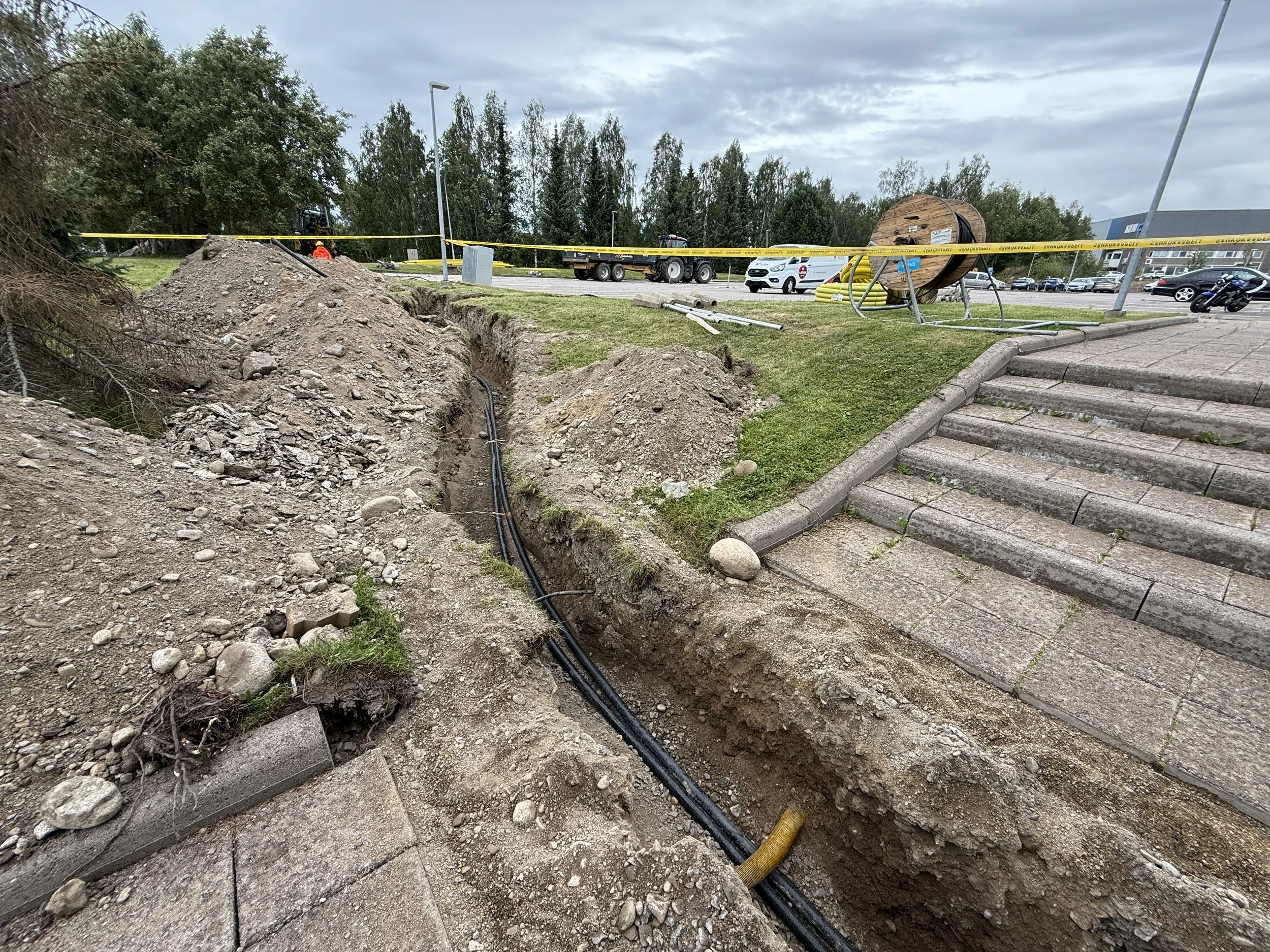Valmet's extensive infrastructure renovation of Lentokentänkatu parking area was completed with impressive parking lot painting
Vera in Tampere implemented a project for Valmet's Tampere Lentokentänkatu site in late summer 2025, which included the construction and design of the entire charging infrastructure. The delivery chain covered everything from the main electrical switchboard to cabling, shelving, excavation and protection, and included an outdoor distribution center, charging poles and charging devices with their deployment. In addition, the area was marked with squares and asphalted, and additional work included renewing the curbstones.
Valmet's renovated parking area on Lentokentänkatu.
“The project was implemented directly for Valmet, for whom we had previously completed two other projects. Valmet already had an operating agreement in place with our partner eParking, which made the implementation of the project easy and straightforward for us,” say Ville Hakamäki and Project Manager Rene Kakkonen .
Desired maximum power and dynamic load management
A total of 26 parking spaces were electrified at the site with 13 charging devices. Two of the charging stations are designated for guest parking and the rest for staff use. “We used two-part Walle 66Tupla charging stations, which we believe offered by far the best technical solution for this purpose. The choice enabled a maximum charging power of 22 kilowatts per plug, in line with Valmet’s target,” Hakamäki describes. 2-level load management was implemented by installing two eParking CAMU load management devices in the center.
CAMU (Compact Ampere Measuring Unit) is a 2-level load management measuring device developed by eParking, which can be used to measure the load of desired measurement points and dynamically adjust the remaining capacity of electric vehicle charging devices. This way, the maximum power consumed by electric vehicle charging devices can be adjusted according to other consumption in the property. If the property has a momentary high electricity consumption, such as the use of air conditioning on a warm summer day, the charging capacity can be reduced and electricity can be released for critical functions in real time.
No surprises underground
According to Hakamäki and Kakkonen, the project was very similar to previous Valmet projects implemented by Vera. “The project included our core expertise, namely laying thick cables and building parking areas. However, we also carried out paving and tile work. In addition, the broken foundation of the yard light pole was renewed during the project by replacing the old foundation with a new one.” The soil in the excavation area was suitable, and there was little other infrastructure in the area, and no critical fiber was encountered on the excavation route, for example.
The entire project took a few months to complete. “We received an offer from Valmet at the beginning of May, and we made a counter-offer at the end of May. Since the contract schedule fell during the summer season, the holiday season had a slightly slowing effect on the progress of the work. Otherwise, the project was a basic work item, and there were no significant surprises along the way. There were only a few challenges with the delivery times of the products, but despite these, we were able to create a clean and functional end result for the customer,” Kakkonen sums up.
The project included Vera's basic expertise: pulling thick cables and building parking areas.
Cost-effective solution: optimized hardware and data transfer
Vera from Tampere made a significant contribution to the functional and cost-effective end result. “We influenced the choice of equipment and proposed our own solution, as it was a cost-effective alternative to individual charging points. Wallelaturit offers a domestic product at a reasonable price. We saw that two-part charging devices were optimal in this context to keep costs reasonable,” Hakamäki and Kakkonen say.
The devices enable a charging power of 11 kW per plug when both plugs are in use. A maximum power of 22 kW is possible when only one plug is used. The solution was implemented cost-effectively with the eParking operating system.
The charging center was also designed with Vera's expertise to be as cost-effective as possible without compromising on functionality. "We developed a simple and functional center that was approved by the client and the electrical designer. In addition, the wireless data transfer used by devices utilizing Walle's eTolppa technology replaced the originally planned fixed network wiring, which also streamlined the delivery," says Kakkonen.
Looking to the future with sufficient reserves
The whole was completed with striking square paintings in the parking area, which indicated the reservation of a charging spot and improved the visual appearance. “We also renewed the paintings of the slow charging spots already in the area, also equipped with devices operated by eParking, and we painted the pedestrian crossing. With these paintings, the overall appearance of the parking area completely changed,” says Hakamäki. Pipe reserves were made for the expansion of the system and expansion funds for the center in order to avoid major changes later.
Vera's own installers in Tampere carried out the equipment deployment in seamless cooperation with eParking's service delivery team. According to Hakamäki and Kakkonen, the cooperation with eParking has continued smoothly since 2018.
For the reference, we interviewed Tampereen Vera's Key Account Manager Ville Hakamäki and Project Manager Rene Kakkonen.
Photos: Tampereen Vera




